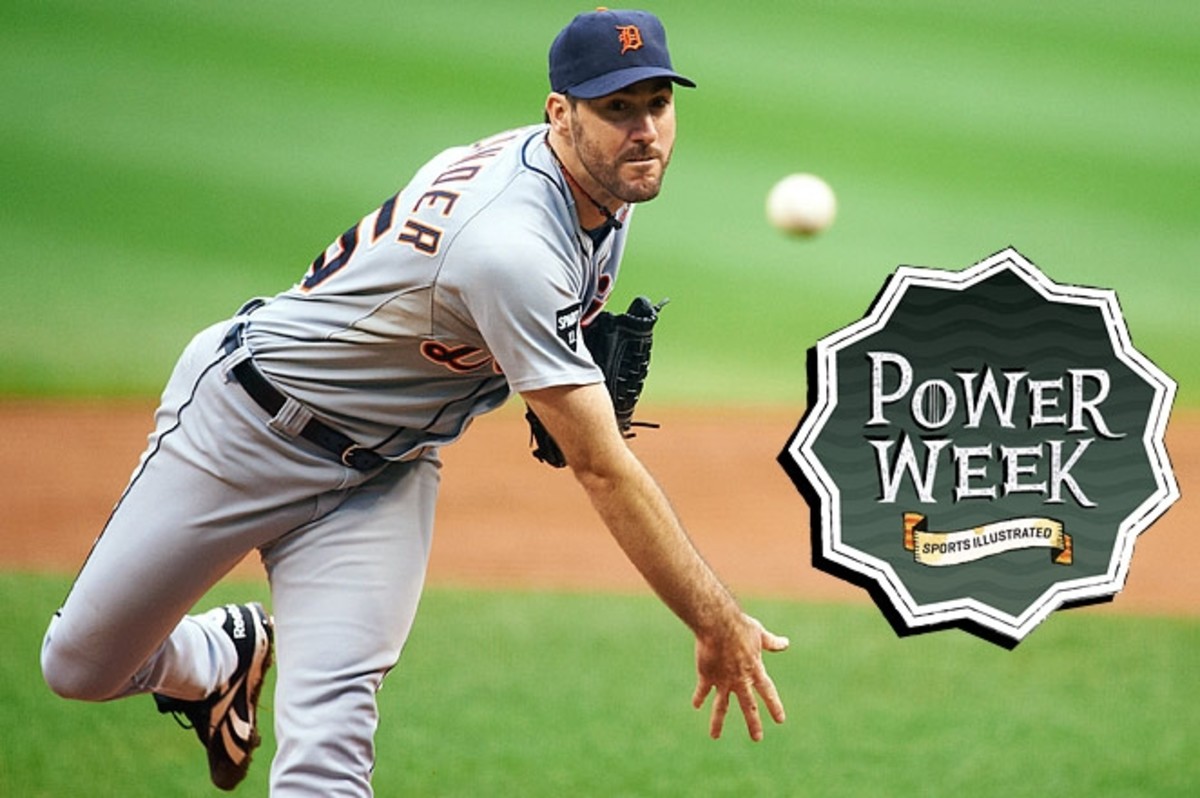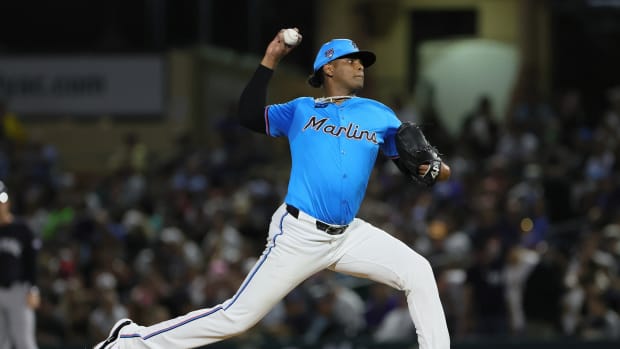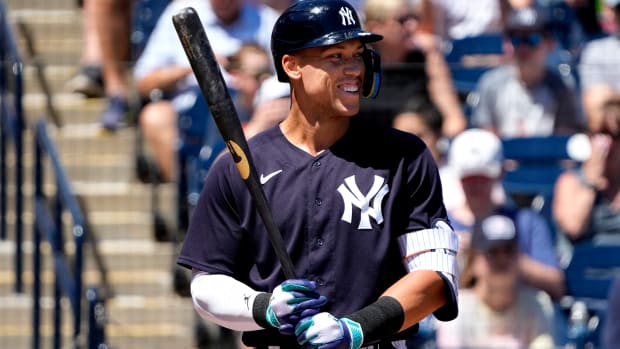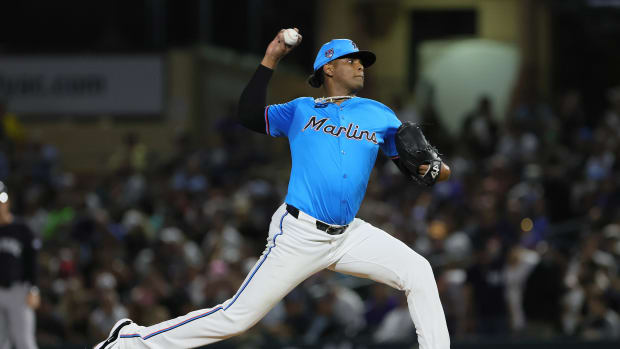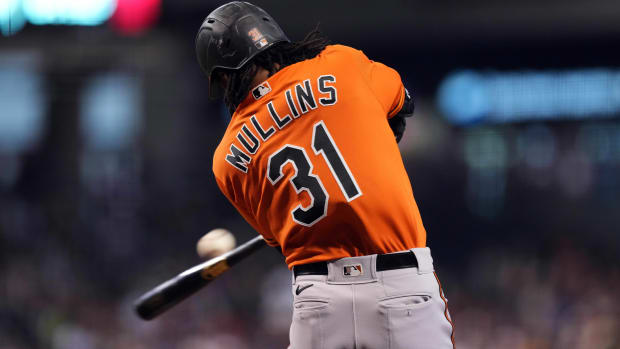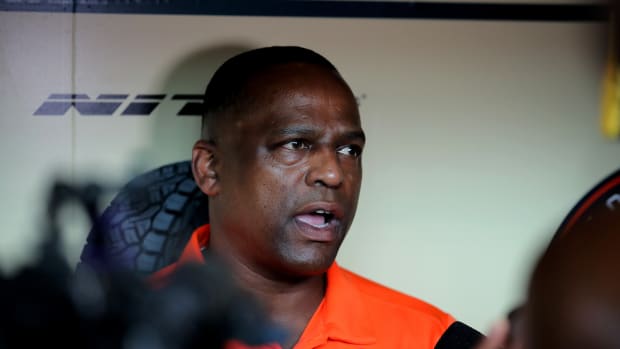The 10 most powerful pitchers in baseball history
There is now an immediate, quantifiable satisfaction that comes from watching a power pitcher at work. As soon as a pitch crosses home plate, every stadium and every television broadcast announces just how fast it was thrown. The sacrifice is that the mystery is gone. For most of the game's history, legendary flamethrowers from Walter Johnson to Nolan Ryan were known by their reputations, not necessarily by the documented and verifiable proof of how hard they threw.
Those pitchers, like the others on this list, need not worry about being eclipsed in the minds of baseball fans, however. Each of these men is on the short list of the hardest throwers in baseball history.
10. Steve Dalkowski
Steve Dalkowski never pitched in the major leagues and made only 12 appearances at the Triple-A level. Yet his famous fastball was so fearsome that he became, as the Sporting News referred to him upon the end of his career in 1966, a living legend. It sure wasn't for his pitching record ? a 46-80 mark with a 5.38 ERA spread over nine minor league seasons, mostly in the Orioles' system. No, Dalkowski's lasting stature is due to a fastball that, without the benefit of ballpark radar guns, was often considered the fastest ever by those who saw him, like Hall of Fame manager Earl Weaver and umpire Doug Harvey. Some estimates said it went 110 mph, but all that's known for certain is that it was fast enough to make Steve Dalkowski a part of baseball history forever. -- Ted Keith
9. Joel Zumaya
Joel Zumaya's dominance was as fleeting as his fastball, a lesson in the fickle nature of power pitching. As a rookie in 2006, the Tigers righthander had a 1.94 ERA and nearly topped 100 strikeouts in 83 1/3 innings. In his first postseason appearance in Game 2 of that year's ALDS, Zumaya retired all five Yankees he faced, striking out and, yes, even overpowering Derek Jeter, Jason Giambi and Alex Rodriguez. In Game 1 of the ALCS, Zumaya hit 104.8 mph on the radar gun in Oakland, at the time the fastest recorded pitch in history. He missed the rest of that series, however, after he hurt his wrist playing the video game Guitar Hero. That was but the first of an array of arm injuries that derailed his career, and he never threw even 40 innings in a season again. -- Joe Lemire
8. Goose Gossage
With his fu manchu mustache, violent cross-body delivery and high-90s heat, Goose Gossage was the prototypical smoke-throwing reliever instilling fear in the hearts of batters. Both he and Nolan Ryan were clocked at 103 mph during the 1978 All-Star Game and Gossage continued to throw upper-90s heat for most of his 22-year career. More impressive than his velocity was the fact that Gossage wasn't simply a one-inning closer. In three seasons, he threw more than 130 innings out of the bullpen, and 74 times he threw at least three innings and finished a game. His 310 saves ranked fifth all-time when he retired in 1994, and while he has fallen to 19th since then, he's one of five relievers to be elected to the Hall of Fame. -- Jay Jaffe
Stephen Strasburg was baseball's most famous and most hyped prospect, due in part to a fastball that reached 102 mph during a dominating career at San Diego State. The Nationals selected him No. 1 overall in June 2009 and he reached the majors almost a year to the day later, striking out 14 Pirates in his big league debut and averaging 98mph with his fastball as a rookie. He blew out his arm in late August 2010 and missed almost a year with Tommy John surgery, but the operation didn't cost him his fastball. When he returned for his first (almost) full season in 2012, he still averaged 97. Alas, Washington shut down the 24-year-old Strasburg a month early in hopes of protecting his valuable right arm, and the resulting controversy incited a national fervor that could only accompany one of the game's most talented pitchers. -- Joe Lemire
With Justin Verlander, it isn't just the velocity, which is considerable and has reached 102 mph, that is so impressive. It's the timing of his fastest pitches. The Tigers ace routinely doubles down on the century mark, throwing 100 at pitch No. 100, making him the rare pitcher whose velocity increases in the late innings. Verlander reached triple digits in the ninth inning of both his career no-hitters -- one in 2007, the other in 2011 -- and with mastery of a full complement of offspeed pitches, he has established himself as the game's best starting pitcher. Need proof? Look no further than his dual awards in 2011 for both AL Cy Young and MVP, not to mention a Cy Young runner-up finish in '12 and the fact the he has topped the majors in both strikeouts and innings in three of the past four seasons. -- Joe Lemire
Aroldis Chapman was just 22 years old, a little over a year removed from his defection from Cuba, and had pitched fewer than 10 major league innings when he set a big league record with a 105.1 mph pitch on Sept. 24, 2010 against the Padres, the fastest ever reliably recorded by the PITCHf/x system.
Since then, the Reds lefty has emerged as a dominant reliever whose ability to crank it up in short stints has become legendary. According to the 2010, 2011 and 2012 editions of The Bill James Handbook, Chapman led the NL in 100+ mph offerings in all three seasons, including his abbreviated 2010 stint. He's reached triple digits an MLB-high 484 times in that span, including 242 last year; the Nationals' Henry Rodriguez is a distant second with 310 triple-digit heaters. Via Baseball Prospectus' park-corrected PITCHf/x data, Chapman's average fastball velocity of 98.8 mph is third among all relievers with at least 1,000 pitches thrown since 2007, when the PITCHf/x system went online, behind Rodriguez (99.1 mph) and Joel Zumaya (99.0).
Whether he'll reach 100 mph this year is in question, because Cincinnati is attempting to convert him to the rotation, which will require him to rein in his famous fastball to maintain his stamina. -- Jay Jaffe
4. Randy Johnson
Randy Johnson won 303 games and five Cy Young awards ? including four in a row from 1999-2002 ? during a career that spanned from 1988 through 2009. The combination of his fastball and slider ? not to mention an imposing scowl coming from atop a 6-foot-10 frame ? helped "The Big Unit" rack up 4,875 strikeouts, second only to Ryan, lead his leagues in strikeouts nine times and top 300 six times; no pitcher has reached that mark since he and Diamondbacks teammate Curt Schilling did so in 2002. Johnson's fastest official fastball velocity was a radar-clocked 102-mph pitch in 2004. Thanks to his extreme height and wingspan, that pitch would have been perceived around 4 mph faster by the batter due to the shorter distance between his release point and home plate. -- Jay Jaffe
3. Nolan Ryan
No pitcher can claim to be more unhittable than Hall of Famer Nolan Ryan, who set the all-time records for strikeouts (5,714), walks (2,795), hits per nine innings (6.6) and no-hitters (seven) during a 27-year major league career that spanned from 1966 to 1993, and from ages 19 to 46. Ryan holds the single-season record for strikeouts (383 in 1973), topped 300 six times (tied with Randy Johnson for the record), and led his leagues in strikeouts 11 times, seven in the eight-year span from 1972-1979 and then four more from 1987-1990, his age 40-43 seasons. In 1989, at the age of 42, he whiffed 301 hitters.
On Aug. 20, 1974, Ryan entered The Guinness Book of World Records with a 100.9 mph pitch. That speed was measured by a laser radar when it was 9-10 feet from the plate; if measured at the standard distance of 50 feet from the plate (as PITCHf/x does), that extrapolates to an astounding 108.1 mph. Even his high-80s curveball was frighteningly fast. "At that speed, the curve would break so hard that it'd take your stomach away," wrote umpire Durwood Merrill in his autobiography, You're Out and You're Ugly Too. -- Jay Jaffe
2. Bob Feller
We'll never know exactly how fast Hall of Fame pitcher Bob Feller could throw, given the scarcity of radar guns back when he played, but it wasn't for lack of trying. About the only reliable reading for Rapid Robert, a 266-game winner over 18 seasons that were interrupted by World War II, came in 1946, when army equipment clocked him at 98.6 mph; that measured the speed as the ball crossed home plate rather than as it left his hand, so one computation had Feller at 107.9 mph (though it was probably in the 101-to-102 range). In a separate stunt his pitch beat a speeding 86-mile-per-hour motorcycle in a race and, when accounting for the motorcycle's headstart and losing margin, Feller was credited with throwing 104. Most important was his success on the mound, aptly described by this summation from Ted Williams, "[Feller was] the fastest and best pitcher I ever saw during my career." -- Joe Lemire
1. Walter Johnson
"He throws so fast you can't see 'em," said the scout who discovered Walter Johnson in 1907, "and he knows where he is throwing, because if he didn't there would be dead bodies strewn all over Idaho." Pitching in a time before lighted ballparks and the routine introduction of fresh baseballs, Johnson had more working to his advantage than just a blazing fastball delivered with deceptive ease from a sidearm angle. In a 21-year career spent entirely with the Washington Senators from 1907-1927, he won 417 games, pitched to a 2.17 ERA and struck out 3,509 hitters, a mark which stood as the record until it was broken by Nolan Ryan in 1983. Even after adjusting for era, his overall numbers give him a reasonable case as the best pitcher ever. Exactly how fast Johnson threw is unknowable, but in 1914, his fastball was measured against a speeding motorcycle and estimated at 97 mph. -- Jay Jaffe






























